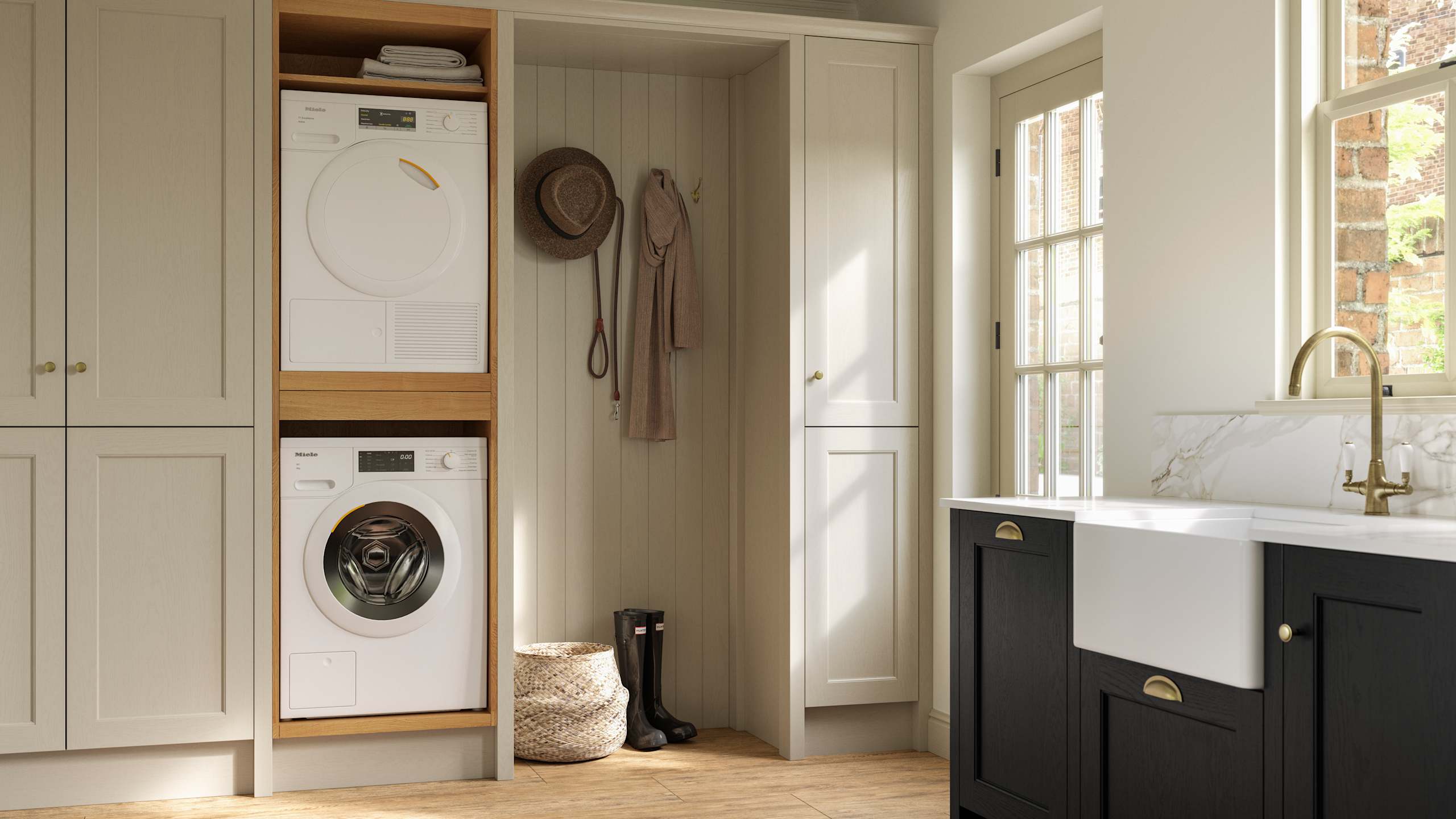Utility Room Ideas
Purpose-built for the heavy lifting of the house, utility rooms have a few common identifying features: the usual white goods, a Belfast or butler sink and the obligatory drying rack for laundry.

But with more innovative designs and decor appearing each year, the playbook for the perfect utility room doesn’t have to stop there.
Utility room design and layout
There are many elements of utility room design that come together to create a functional and enjoyable space.
Countertops
Utility room worktops should be durable and non-porous. Natural woods, even when sealed, can absorb liquid and stain if spills aren’t dealt with quickly.
Concrete is hardwearing and suits an industrial-style space, however, it might not be the best choice for laundry tasks. A smoother, slippier surface, such as stainless steel, quartz or acrylic can make folding laundry easier and won’t snag delicate items. Engineered stone is also resistant to moisture and bacteria build-up.
Sink unit
While not every utility room has a sink, it’s unusual to compromise on this feature.
Large single-compartment Belfast sinks are a mainstay of the utility room aesthetic while double sinks in ceramic, steel or granite are also popular choices. A large double sink, like this Caple Chepstow Belfast Sink, allows for separate spaces to wash and drain items without taking up countertop space.
It’s often recommended to have a “work triangle” between the sink and the washer and dryer. This allows you to pre-treat stains in the sink before transferring laundry to the washer and finally the dryer or rack efficiently.
A good-sized utility room sink isn’t just for laundry purposes, either. They’re also great for washing bulky items from the kitchen, like enormous stovetop pans, or from the garden when cooking with outdoor BBQ equipment.
Team a utility sink with a mixer or pre-rinse spray tap to handle these larger-scale clean-up operations easily.


Appliances and ventilation systems
The main appliances in a utility room are washers and dryers. The traditional side-by-side layout allows for additional countertop space above for sorting and folding laundry, or extra storage cabinets. However, many choose to stack these appliances, particularly in smaller spaces.
If you’re stacking your washer and dryer vertically, the washing machine should always be placed on the bottom, since it contains a concrete slab to reduce shuddering during cycles. In the event that the concrete slab detaches, a washing machine can easily jolt itself off a countertop.
Your layout will also need to consider heat and moisture from these appliances. A vented tumble dryer will need access to an external air vent, while others will need nearby windows for ventilation. To prevent further heat and moisture build-up inside the room, you can also add a dehumidifier.
Pet-friendly spaces
Whether your pet likes to join you on long laundry days or simply seeks out the toastiest spot in the house (usually when the dryer is running), you’ll want to make a homely spot for them in your utility room.
A nook or space under a free cabinet is a perfect place to make a cosy bed and keep the “pack” together while you’re squirrelled away on laundry day.
A modern utility room idea that has captured the attention of serious dog lovers is the purpose-built dog bath. This luxurious installation is an all-brick or tiled mini bath that you can lift your dog into after the muddiest of walks.
If you don’t want to install double wash basins in your utility space but still want to pamper your pooch, a vintage-style copper tub for pet baths is a great alternative and a beautiful feature for a Victorian-style utility room.
Storage solutions
No utility room would be complete without functional storage, and there are a variety of multi-purpose options for hardworking spaces.
Shelves and cabinets
Many utility room designs not only provide storage space for cleaning products and tools but also for concealing dirty laundry piles as well.
If you plan to install laundry storage cabinets, consider that these will likely need to be big enough to stuff in an entire double duvet set, one that’s used and crumpled, as well as bulky bath towels and jumpers.
When adding open shelves to your utility space, hampers, baskets and caddies allow you to easily locate and impose order on products for different household tasks. They’re also great for concealing unsightly bulk-buy items like toilet rolls and detergents.
If the blueprint of your home allows, a drop chute from an upstairs airing cupboard to a countertop or cupboard in the utility room below is an incredibly innovative utility room idea. No more marching up and down stairs with an overflowing basket, this invention effortlessly delivers laundry loads right to the utility room.


Tall cupboards
These are essential for hiding away brooms, ironing boards, collapsed drying racks and vacuum cleaners - all those items that take up vital floor space, even when stacked against kitchen corners.
For space-strapped families or group homes, vertical storage is one of the most useful small utility room ideas. You might find they become a helpful receptacle for umbrellas, bicycle pumps, and possibly the odd cricket bat, too
Hanging drying racks
A boon for small and large utility spaces, hanging drying racks ensure laundered clothes remain out of the way while also capturing rising heat from the room.
Collapsable wall-mounted drying racks can be positioned above countertops and sinks and pulled downwards while surfaces are not in use. Ceiling suspended drying racks are best for larger rooms, where they won’t obstruct windows and cabinets, and higher ceilings.
Under-shelving hooks, pegs, and rails also make a great space-saving spot for newly- ironed shirts.
Shoe cupboards
Few doorways or porches offer sufficient space for the avalanche of footwear from busy families and the utility room often doubles up as a boot or cloakroom, too.
A boot rack, shoe storage cabinet or hallway unit with a bench to sit on for unlacing, will help with any overspill of messy outdoor items that find their way into the space.
Decor
Utility room decor usually conveys the functional purpose of the room. This might naturally extend or take inspiration from the kitchen, depending on where your utility room is placed. Or, it can display a style of its own.
When picking out your style, there are some key decorative choices to make:
Flooring
Tiles or flat stone floors offer a level surface for large appliances. They can also handle any drips from wet clothing or unfortunate washing machine leakages.
Ceramic red or black and white harlequin floor tiles are a popular choice and create a functional Victorian aesthetic, while large stone slabs or tiles offer a more rustic appearance.

Utility rooms designed by us, styled by you

Colours
Dark-coloured cabinets are more forgiving of dirty marks and can look striking in larger utility spaces.
Pale greys and light blues are soothing options for more chaotic cleaning days, while earthy tones and natural colours are classics for a country home aesthetic.
Doors
While a regular door or entranceway will do just fine, there are some inspired options for expanding the reach of your utility room.
Depending on the size of the room and the flow of decor from neighbouring rooms, a glass door leading to a kitchen or bright hallway could be a great option for bringing more light into smaller utility spaces and creating visual continuity.
For the smallest of joined spaces, a sliding door is another great option, which also allows the room to benefit from additional light.






























